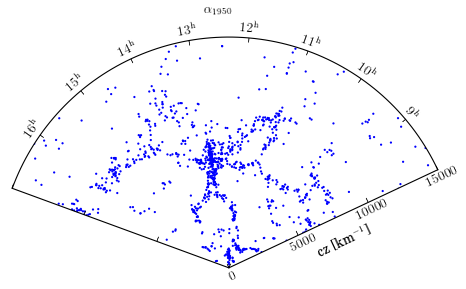CfA Survey¶
- requires svn version of matplotlib or future release (>0.99.1)
- FortranFormat.py (from ScientifiPython)
- data file from http://www.cfa.harvard.edu/~huchra/zcat/
from matplotlib.transforms import Affine2D
from mpl_toolkits.axisartist.floating_axes import FloatingSubplot,\
GridHelperCurveLinear
import numpy as np
import mpl_toolkits.axisartist.angle_helper as angle_helper
from matplotlib.projections import PolarAxes
def setup_axes(fig):
# rotate a bit for better orientation
tr_rotate = Affine2D().translate(-95, 0)
# scale degree to radians
tr_scale = Affine2D().scale(np.pi/180., 1.)
tr = tr_rotate + tr_scale + PolarAxes.PolarTransform()
grid_locator1 = angle_helper.LocatorHMS(8)
tick_formatter1 = angle_helper.FormatterHMS()
#from mpl_toolkits.axes_grid.grid_finder import FixedLocator
#grid_locator2 = FixedLocator([0., 5000, 10000, 15000])
from mpl_toolkits.axisartist.grid_finder import MaxNLocator
grid_locator2 = MaxNLocator(3)
ra0, ra1 = 8.01*15, 16.99*15
cz0, cz1 = 0, 15000
grid_helper = GridHelperCurveLinear(tr,
extremes=(ra1, ra0, cz1, cz0),
grid_locator1=grid_locator1,
grid_locator2=grid_locator2,
tick_formatter1=tick_formatter1,
tick_formatter2=None,
)
ax1 = FloatingSubplot(fig, 111, grid_helper=grid_helper)
fig.add_subplot(ax1)
# adjust axis
ax1.axis["left"].toggle(ticklabels=False)
ax1.axis["right"].toggle(ticklabels=True)
ax1.axis["right"].set_axis_direction("bottom")
ax1.axis["right"].label.set_visible(True)
#ax1.axis["right"].major_ticklabels.set_pad(5) #label.set_visible(True)
ax1.axis["bottom"].major_ticklabels.set_axis_direction("top")
ax1.axis["bottom"].label.set_axis_direction("top")
ax1.axis["top"].set_visible(False)
ax1.axis["right"].label.set_text(r"cz [km$^{-1}$]")
ax1.axis["bottom"].label.set_text(r"$\alpha_{1950}$")
#ax1.axis["right"].set_visible(False)
#ax1.axis["bottom"].set_visible(False)
#ax1.axis["left"].set_visible(False)
# create a parasite axes whose transData in RA, cz
aux_ax = ax1.get_aux_axes(tr)
aux_ax.patch = ax1.patch # for aux_ax to have a clip path as in ax
ax1.patch.zorder=0.9 # but this has a side effect that the patch is
# drawn twice, and possibly over some other
# artists. So, we decrease the zorder a bit to
# prevent this.
return ax1, aux_ax
def sixty(d, m, s):
return d + (m + s/60.)/60.
def load_data():
"""
read in data
"""
import FortranFormat as FF
ll = open("n30.dat").readlines()
lll = ll[29:-8] #[-10:]
format = FF.FortranFormat("A11,I2,I2,F4.1,A1,I2,I2,I2,F5.2,I5")
alphas, deltas, mags, czs = [], [], [], []
for l in lll:
line = FF.FortranLine(l, format)
alpha = sixty(line[1], line[2], line[3]) * 15.# alpha
sgn = {"-":-1}.get(line[4], 1)
delta = sgn*sixty(line[5], line[6], line[7]) # delta
mag = line[8]
cz = line[9]
alphas.append(alpha)
deltas.append(delta)
mags.append(mag)
czs.append(cz)
alphas = np.array(alphas)
deltas = np.array(deltas)
mags = np.array(mags)
czs = np.array(czs)
return alphas, czs
if 1:
alphas, czs = load_data()
import matplotlib.pyplot as plt
fig = plt.figure(1, figsize=(7, 5))
fig.clf()
ax, aux_ax = setup_axes(fig)
sct = aux_ax.scatter(alphas, czs, s=4, edgecolors="none")
plt.show()
[source code, hires.png, pdf]
